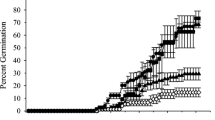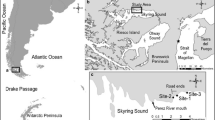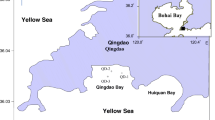Abstract
Seagrass fragments and seeds are important dispersal mechanisms by which individuals can be transported to new habitats. While dispersal distances of these free-floating stages have been recently investigated in some detail, almost nothing is known about how long fragments or seedlings may remain viable in the water-column. This study reports on the results of an experiment in which both mature and seedling life-history stages of the temperate seagrass, Zostera marina L. were successfully maintained hydroponically over a 1-month-period. It is suggested that a potential application of this hydroponic growth approach could be seedling culture for restoration activities.
Similar content being viewed by others
References
Beer S., Bjork M., Gademan R. and Ralph P. (2001). Measurements of photosynthetic rates in seagrasses. In: Short, F. T., Coles, R. G., and Short, C. A. (eds) Global Seagrass Research Methods, pp 183–198. Elsevier, Amsterdam
Bird K. T., Jewett-Smith J. and Fonseca M. S. (1994). Use of in-vitro propagated Ruppia maritima for seagrass meadow restoration. Journal of Coastal Research 10: 732–737
Durako M. J. and Kunzelman J. I. (2002). Photosynthetic characteristics of Thalassia testudinum measured in situ by pulse-amplitude modulated (PAM) fluorometry: methodological and scale-based considerations. Aquatic Botany 73: 173–185
Fonseca, M. S., W. J. Kenworthy & G. W. Thayer, 1998. Guidelines for the Conservation and Restoration of Seagrasses in the United States and Adjacent Waters. NOAA Coastal Ocean Program Decision Analysis Series No. 12. NOAA Coastal Ocean Office, Silver Spring, MD
Hall L. M. (2002). Fragments of the seagrasses Halodule wrightii and Halophila johnsonii as potential recruits in Indian River Lagoon, Florida. MS Thesis, Florida Institute of Technology, Melbourne, FL
Harwell M.C. and Orth R.J. (2002). Long-distance dispersal potential in a marine macrophyte. Ecology 83: 3319–3330
Koch M. S., Mendelssohn I. A. and McKee K. L. (1990). Mechanism for the hydrogen sulfide-induced growth limitation in wetland macrophytes. Limnology and Oceanography 35: 399–408
Koch M. S. and Erskine J. M. (2001). Sulfide as a phytotoxin to the tropical seagrass Thalassia testudinum: interactions with light, salinity and temperature. Journal of Experimental Marine Biology and Ecology 266: 81–95
Lee K. S. and Dunton K. H. (2000). Diurnal changes in pore water sulfide concentrations in the seagrass Thalassia testudinum beds: the effects of seagrasses on sulfide dynamics. Journal of Experimental Marine Biology and Ecology 255: 201–214
Nelson W. G. (1979). An analysis of structural pattern in an eelgrass (Zostera marina L.) amphipod community. Journal of Experimental Marine Biology and Ecology 39: 231–264
Orth R. J., Luckenback M. and Moore K. A. (1994). Seed dispersal in a marine macrophyte: implications for colonization and restoration. Ecology 75: 1927–1939
Author information
Authors and Affiliations
Corresponding author
Rights and permissions
About this article
Cite this article
Biber, P.D. Hydroponic versus rooted growth of Zostera marina L. (Eelgrass). Hydrobiologia 568, 489–492 (2006). https://doi.org/10.1007/s10750-006-0115-2
Received:
Revised:
Accepted:
Published:
Issue Date:
DOI: https://doi.org/10.1007/s10750-006-0115-2




